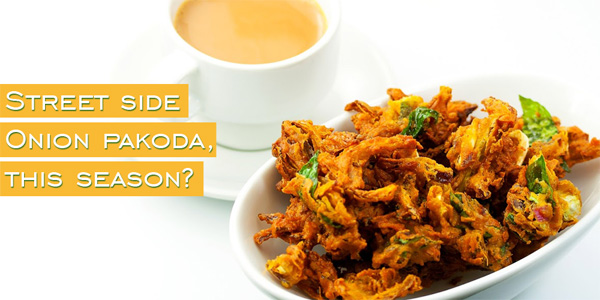Who can avoid hot Kanda bhaji or Kanda bhajiya, the most tempting snack of this season? This roadside delicacy is as dangerous as delicious.
The rains have brought a pleasant and cool climate for us. Rainy season not only makes us happy and romantic but also fires up our appetite, isn’t it? We love to snack on spicy and fried dishes this season. While you enjoy the heavenly combination of chai & pakodas in the rains, it’s important to take extra care of your health and avoid catching infections or diseases. Unhealthy eating habits and lack of hygiene can lead to stomach infections, diarrhea and digestive problems.
If you are at home and it starts pouring make yourself some crispy onion pakodas without thinking twice. Trust us that is a very good option as compared to eating at roadside stalls. Homemade food with fresh ingredients has no comparison to roadside food.
Why say “No” to street Onion Pakodas:
- Do you know what kind of oil is being used? It may be adulterated and unhealthy.
- How have the vegetables and spices been handled while food preparation? The rainy season adds to breeding of bacterial and fungus contamination.
- The food you may be relishing, may have been exposed to flies and other pests if kept uncovered.
- Have you ever seen a vendor wear gloves or have access to clean water to wash his hands and utensils? The answer is mostly negative.
- Most of the vendors operating the stall lack adequate understanding of the basic safety and hygiene issues.
- The main reasons for microbial contamination are – unhygienic place of preparation of food, dirty utensils used, raw materials, inadequate solid waste management systems and the personal hygiene of the vendors.
- There have been cases where street food has been tested and high volumes of E. coli bacteria and faecal matter have been found.
- The bacterial pathogens commonly found in street eateries are Bacillus cereus (causes vomiting and diarrhoea), Clostridium perfringens (abdominal cramps and diarrhoea), Staphylococcus aureus (vomiting, appetite loss, abdominal cramps and mild fever), and Salmonella species (typhoid, food poisoning, irritation and inflammation in the gastrointestinal tract).
Are you are experiencing digestive problems or other infections this season?
Sometimes home remedies and other precautions may not be enough. Visit us at Kokilaben Dhirubhai Ambani hospital for consultations or book an appointment at :
https://www.kokilabenhospital.com/patients/makeanappointment.html
Be it an office snack break or an outing with friends, strictly say no to roadside Onion Pakodas. Eat healthy and be healthy this season!


